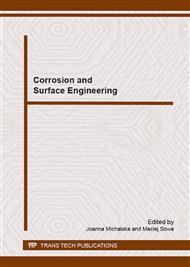p.171
p.174
p.178
p.185
p.190
p.194
p.199
p.203
p.207
Deterioration of Cement Composites with Silica Fume Addition due to Chemical and Biogenic Corrosion Processes
Abstract:
The paper is aimed at comparative study of resistance of Portland cement composites with addition of silica fume as durability increasing factor in various aggressive environments (sulphuric acid with pH 4, the medium of activated bacteria and the cultivating medium without bacteria) during 150 days under model laboratory conditions. Experimental studies confirmed: the leaching of silicon ions calculated to 1 g of concrete sample affected with bacteria Acidithiobacillus thiooxidans was 2.5 times lower (31.78 mg/g of sample) for concrete sample with silica fume addition comparing to concrete sample of ordinary CEM I Portland cement without any additives (82.98 mg/g of sample). The highest concentration of calcium ions released (60.808 mg/g of sample) was observed for reference sample without silica fume addition placed in the cultivating medium. Silica fume based concrete samples were found to have better performance in terms of calcium ions leaching for all environments and silicon ions leaching.
Info:
Periodical:
Pages:
190-193
Citation:
Online since:
January 2015
Authors:
Keywords:
Price:
Сopyright:
© 2015 Trans Tech Publications Ltd. All Rights Reserved
Share:
Citation:


